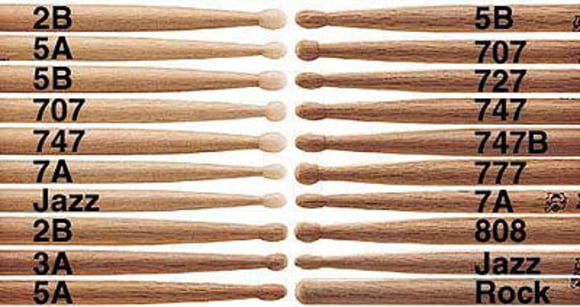8. Accessories
Drum Sticks
Naturally, you will need sticks to play the drums. Again, the "middle of the road" is a good starting point for beginners. Size 5A sticks (medium thickness, medium weight and medium length) are a good choice. Drum sticks are available in a variety of woods, shaft profiles, thicknesses, lengths, and weights and their tips come in different shapes and materials.
Hickory and maple are the most commonly used woods, while some inexpensive sticks are made out of hornbeam. There are also drum sticks made from carbon fibre and plastic-coated aluminium.
Depending on the weight and length of the stick it will feel and react differently. This affects the punch (strength of a drum hit) and rebound. While the drummer can compensate for weaknesses of the sticks by adopting different playing positions, this can have negative effects on strength and endurance while playing. The properties of the tips of the sticks greatly affect the sound of the cymbals. Wooden tips with a large contact area produce a more muffled sound than hard plastic tips.
Drum sticks are consumable items. Over time, nicks and dents will appear as you hit the drums, rims and cymbals, and every drum stick will eventually break. There's nothing worse than setting up the drum kit, only to discover that all of your sticks are broken. So it's a good idea to always order an additional pair so you never run out.

Tuning key
For assembly and tuning of the drums, you should always have a drum key on hand. You'll soon discover its importance when you decide to tune the drums, change a drum head or – at the very worst – when an old head ruptures during a gig. A drum key is normally included with complete kits.
Yhteyshenkilösi
Product Highlights
Tarjoukset
-
Kokonaiset rumpusetit
-
Sähkörumpusetit
-
Rumpuoppaat
-
Nuottikirjoja rummuille ja perkussioille
-
Rumpuvideot






